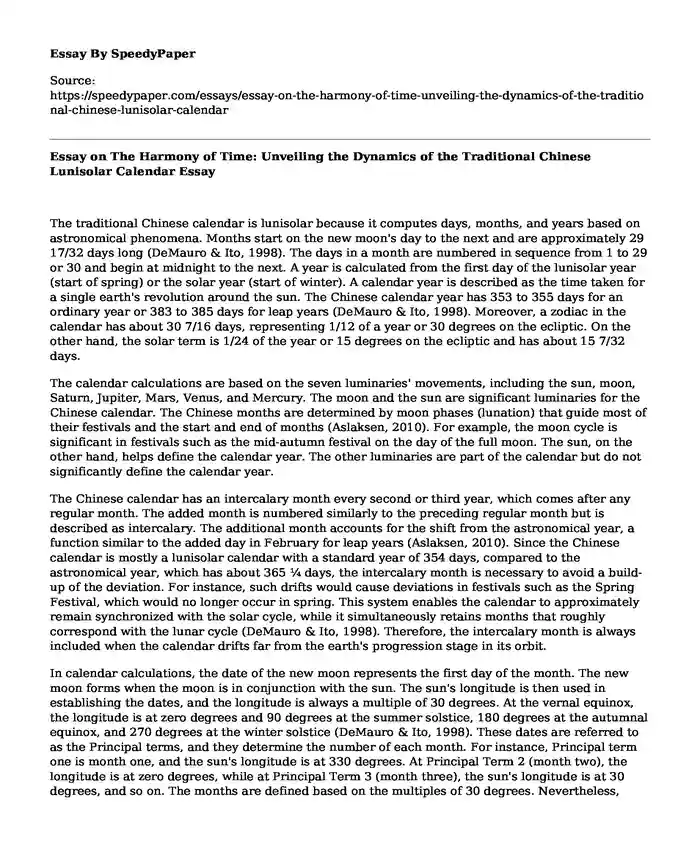
| Type of paper: | Essay |
| Categories: | Culture |
| Pages: | 3 |
| Wordcount: | 689 words |
The traditional Chinese calendar is lunisolar because it computes days, months, and years based on astronomical phenomena. Months start on the new moon's day to the next and are approximately 29 17/32 days long (DeMauro & Ito, 1998). The days in a month are numbered in sequence from 1 to 29 or 30 and begin at midnight to the next. A year is calculated from the first day of the lunisolar year (start of spring) or the solar year (start of winter). A calendar year is described as the time taken for a single earth's revolution around the sun. The Chinese calendar year has 353 to 355 days for an ordinary year or 383 to 385 days for leap years (DeMauro & Ito, 1998). Moreover, a zodiac in the calendar has about 30 7/16 days, representing 1/12 of a year or 30 degrees on the ecliptic. On the other hand, the solar term is 1/24 of the year or 15 degrees on the ecliptic and has about 15 7/32 days.
The calendar calculations are based on the seven luminaries' movements, including the sun, moon, Saturn, Jupiter, Mars, Venus, and Mercury. The moon and the sun are significant luminaries for the Chinese calendar. The Chinese months are determined by moon phases (lunation) that guide most of their festivals and the start and end of months (Aslaksen, 2010). For example, the moon cycle is significant in festivals such as the mid-autumn festival on the day of the full moon. The sun, on the other hand, helps define the calendar year. The other luminaries are part of the calendar but do not significantly define the calendar year.
The Chinese calendar has an intercalary month every second or third year, which comes after any regular month. The added month is numbered similarly to the preceding regular month but is described as intercalary. The additional month accounts for the shift from the astronomical year, a function similar to the added day in February for leap years (Aslaksen, 2010). Since the Chinese calendar is mostly a lunisolar calendar with a standard year of 354 days, compared to the astronomical year, which has about 365 ¼ days, the intercalary month is necessary to avoid a build-up of the deviation. For instance, such drifts would cause deviations in festivals such as the Spring Festival, which would no longer occur in spring. This system enables the calendar to approximately remain synchronized with the solar cycle, while it simultaneously retains months that roughly correspond with the lunar cycle (DeMauro & Ito, 1998). Therefore, the intercalary month is always included when the calendar drifts far from the earth's progression stage in its orbit.
In calendar calculations, the date of the new moon represents the first day of the month. The new moon forms when the moon is in conjunction with the sun. The sun's longitude is then used in establishing the dates, and the longitude is always a multiple of 30 degrees. At the vernal equinox, the longitude is at zero degrees and 90 degrees at the summer solstice, 180 degrees at the autumnal equinox, and 270 degrees at the winter solstice (DeMauro & Ito, 1998). These dates are referred to as the Principal terms, and they determine the number of each month. For instance, Principal term one is month one, and the sun's longitude is at 330 degrees. At Principal Term 2 (month two), the longitude is at zero degrees, while at Principal Term 3 (month three), the sun's longitude is at 30 degrees, and so on. The months are defined based on the multiples of 30 degrees. Nevertheless, some months may contain two principal terms hence the need to shift the month numbers. One notable thing in the calendar year is that Principal term 11, which has 270 degrees and is the winter solstice, should always lie in the 11th month (DeMauro & Ito, 1998). The equinoxes and solstices remain relatively constant in the lunisolar calendar. The 12-month calendar year is approximately 11 days shorter, causing the equinoxes and solstices to move 10, 11, or 12 days forward (Aslaksen, 2010). However, in the 13-month leap year, which is about 19 days longer, the equinoxes and solstices jump back by 18, 19, or 20 days.
References
Aslaksen, H. (2010). The mathematics of the Chinese calendar. National University of Singapore.
DeMauro, L., & Ito, Y. (1998). The Chinese calendar. New York: Macmillan/McGraw-Hill.
Cite this page
Essay on The Harmony of Time: Unveiling the Dynamics of the Traditional Chinese Lunisolar Calendar. (2024, Jan 02). Retrieved from https://speedypaper.com/essays/essay-on-the-harmony-of-time-unveiling-the-dynamics-of-the-traditional-chinese-lunisolar-calendar
Request Removal
If you are the original author of this essay and no longer wish to have it published on the SpeedyPaper website, please click below to request its removal:
- Essay Sample on Diversity and Cultural Competence
- Essay Example about 1950s-1970s Social Movements
- Essay Sample on Gender Stereotype in Children Literature
- Cultural Diversity and Business Environment - Discussion Paper Example
- Uplifting Underprivileged Society Through Community Education - Essay Sample
- Free Essay Example on Leadership and Organizational Change: A Case Study of Desjardins Group
- Free Paper Sample on Organizational Information
Popular categories




